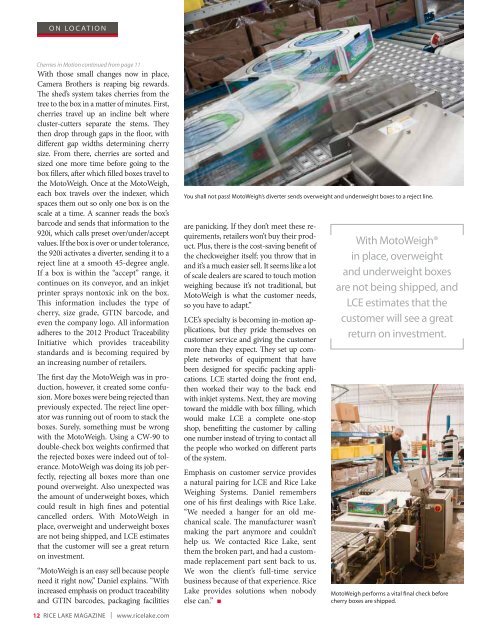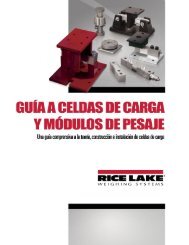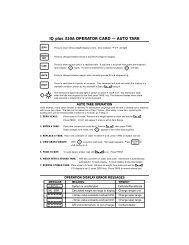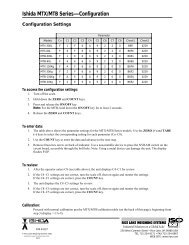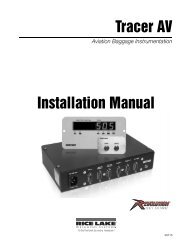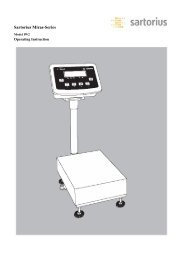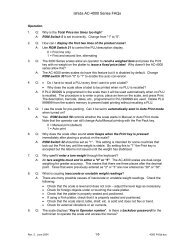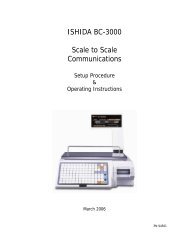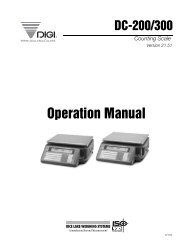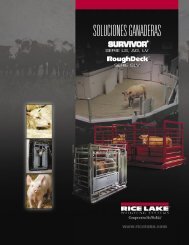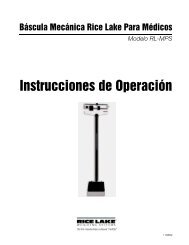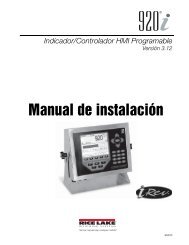English - Rice Lake Weighing Systems
English - Rice Lake Weighing Systems
English - Rice Lake Weighing Systems
Create successful ePaper yourself
Turn your PDF publications into a flip-book with our unique Google optimized e-Paper software.
on location<br />
Cherries in Motion continued from page 11<br />
With those small changes now in place,<br />
Camera Brothers is reaping big rewards.<br />
The shed’s system takes cherries from the<br />
tree to the box in a matter of minutes. First,<br />
cherries travel up an incline belt where<br />
cluster-cutters separate the stems. They<br />
then drop through gaps in the floor, with<br />
different gap widths determining cherry<br />
size. From there, cherries are sorted and<br />
sized one more time before going to the<br />
box fillers, after which filled boxes travel to<br />
the MotoWeigh. Once at the MotoWeigh,<br />
each box travels over the indexer, which<br />
spaces them out so only one box is on the<br />
scale at a time. A scanner reads the box’s<br />
barcode and sends that information to the<br />
920i, which calls preset over/under/accept<br />
values. If the box is over or under tolerance,<br />
the 920i activates a diverter, sending it to a<br />
reject line at a smooth 45-degree angle.<br />
If a box is within the “accept” range, it<br />
continues on its conveyor, and an inkjet<br />
printer sprays nontoxic ink on the box.<br />
This information includes the type of<br />
cherry, size grade, GTIN barcode, and<br />
even the company logo. All information<br />
adheres to the 2012 Product Traceability<br />
Initiative which provides traceability<br />
standards and is becoming required by<br />
an increasing number of retailers.<br />
The first day the MotoWeigh was in production,<br />
however, it created some confusion.<br />
More boxes were being rejected than<br />
previously expected. The reject line operator<br />
was running out of room to stack the<br />
boxes. Surely, something must be wrong<br />
with the MotoWeigh. Using a CW-90 to<br />
double-check box weights confirmed that<br />
the rejected boxes were indeed out of tolerance.<br />
MotoWeigh was doing its job perfectly,<br />
rejecting all boxes more than one<br />
pound overweight. Also unexpected was<br />
the amount of underweight boxes, which<br />
could result in high fines and potential<br />
cancelled orders. With MotoWeigh in<br />
place, overweight and underweight boxes<br />
are not being shipped, and LCE estimates<br />
that the customer will see a great return<br />
on investment.<br />
“MotoWeigh is an easy sell because people<br />
need it right now,” Daniel explains. “With<br />
increased emphasis on product traceability<br />
and GTIN barcodes, packaging facilities<br />
You shall not pass! MotoWeigh’s diverter sends overweight and underweight boxes to a reject line.<br />
are panicking. If they don’t meet these requirements,<br />
retailers won’t buy their product.<br />
Plus, there is the cost-saving benefit of<br />
the checkweigher itself; you throw that in<br />
and it’s a much easier sell. It seems like a lot<br />
of scale dealers are scared to touch motion<br />
weighing because it’s not traditional, but<br />
MotoWeigh is what the customer needs,<br />
so you have to adapt.”<br />
LCE’s specialty is becoming in-motion applications,<br />
but they pride themselves on<br />
customer service and giving the customer<br />
more than they expect. They set up complete<br />
networks of equipment that have<br />
been designed for specific packing applications.<br />
LCE started doing the front end,<br />
then worked their way to the back end<br />
with inkjet systems. Next, they are moving<br />
toward the middle with box filling, which<br />
would make LCE a complete one-stop<br />
shop, benefitting the customer by calling<br />
one number instead of trying to contact all<br />
the people who worked on different parts<br />
of the system.<br />
Emphasis on customer service provides<br />
a natural pairing for LCE and <strong>Rice</strong> <strong>Lake</strong><br />
<strong>Weighing</strong> <strong>Systems</strong>. Daniel remembers<br />
one of his first dealings with <strong>Rice</strong> <strong>Lake</strong>.<br />
“We needed a hanger for an old mechanical<br />
scale. The manufacturer wasn’t<br />
making the part anymore and couldn’t<br />
help us. We contacted <strong>Rice</strong> <strong>Lake</strong>, sent<br />
them the broken part, and had a custommade<br />
replacement part sent back to us.<br />
We won the client’s full-time service<br />
business because of that experience. <strong>Rice</strong><br />
<strong>Lake</strong> provides solutions when nobody<br />
else can.” ▪<br />
With MotoWeigh®<br />
in place, overweight<br />
and underweight boxes<br />
are not being shipped, and<br />
LCE estimates that the<br />
customer will see a great<br />
return on investment.<br />
MotoWeigh performs a vital final check before<br />
cherry boxes are shipped.<br />
12 RICE LAKE MAGAZINE | www.ricelake.com


